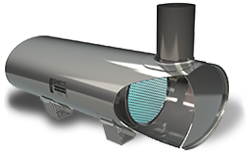Check our 3-Way Catalytic Converters designed especially for gasoline and gaseous LSI and SSI engines
Can NH3 or H2S Be Formed in a Three-Way Catalyst?
Ammonia (NH3) and hydrogen sulfide (H2S) are both gases of obnoxious, characteristic odours. Ammonia, especially at higher concentrations, is a stifling gas causing irritation of eyes and the respiratory system. Hydrogen sulfide is the main compound of the “rotten egg” smell. Both gases are sensed by the human nose at very low concentrations. Therefore, their presence in the exhaust gases from vehicles operated in enclosed spaces is usually a matter of discomfort and appearance rather than a health hazard.
Ammonia and hydrogen sulfide can be generated in small quantities as undesired by-products from emission control catalysts, especially from three-way catalysts. Ammonia is generated by reduction of nitric oxide. Under regular circumstances, NO is reduced to nitrogen in the three-way catalyst. Under favorable conditions the reduction of NO does not stop at N2 but continues to NH3.
Hydrogen sulfide is generated in a similar manner from sulfur compounds that are present in the fuel. Therefore, the H2S formation is also dependent upon the sulfur content of the fuel. Most of the fuel sulfur is present in the exhaust gases as sulfur dioxide, SO2. In the three-way catalyst, under favorable conditions, SO2 may be reduced to H2S.
All conditions that favor or enhance the chemical reduction activity of the three-way catalyst are likely to increase the formation of NH3 and H2S. These conditions include:
- high catalyst temperatures
- low exhaust gas space velocities
- rich fuel mixtures.
H2S is typically smelled on a busy highway whenever cars slow down or stop after a period of high speed cruising. At such moments the catalyst is very hot and the exhaust gas flow rate is very low which are precisely the conditions favoring H2S formation.
H2S formation can be prevented or limited by incorporating H2S suppressants into the catalyst washcoat. This is commonly done in today’s automotive catalyst technologies in North America. The three-way catalysts offered by Nett Technologies for the LPG forklift market, do include H2S suppressants.
H2S and NH3 formation from a given catalyst can be minimized or eliminated by tuning the engine to a leaner mixture. Whenever three-way catalysts are used in an uncontrolled system (“open loop control”), care should be taken than the engine is running at a slightly lean a/f mixture. This becomes especially important if H2S odor becomes a concern.
Nett Technologies’ 3-Way Catalytic Converters

Request A Quote
Photo Gallery

